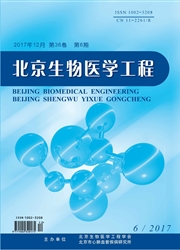

 中文摘要:
中文摘要:
目的 针对用于监测微波热疗凝固区域的超声回波信号信噪比较低,强反射点较多,难以定位凝固区域边缘的特点,研究了一种基于小波分解的去噪方法.方法 在理论分析的基础上,对超声回波信号进行小波分解,根据不同频段信号的特征,进行局部分层小波阈值去噪,再通过小波重构得到去噪后的超声回波信号.结果 对比硬阈值去噪、软阈值去噪和本文所采用方法的效果,探讨了利用本文算法进行凝固区域边缘识别的可行性.结论 局部分层小波去噪算法可有效抑制噪声,保留信号的细节特征,达到优化超声回波信号的目的.
 英文摘要:
英文摘要:
Objective In the monitoring process of the microwave hyperthermia, the ultrasonic echo signals were acquired with low signal noise ratio (SNR) , a large number of strong reflection points, indistinct edges of coagulation zones. A denoising method based on the wavelet decomposition was studied in this paper. Methods Based on the theoretical research, an ultrasonic echo signal was decomposed into different frequency bands through wavelet transformation. According to the characteristics of these frequency bands, the signal was denoised by local multi-level threshold method and the denoised signal was obtained by wavelet reconstruction. Results The denoising effects of hard threshold,soft threshold and local multi-level threshold respectively were compared based on the experimental data. The feasibility of using this method to identify the edge of the coagulation zone was also investigated. Conclusions The experimental results showed that the local multi-level threshold method could depress noises effectively and retain the detailed characteristics to optimize the ultrasonic echo signals.
 同期刊论文项目
同期刊论文项目
 同项目期刊论文
同项目期刊论文
 期刊信息
期刊信息
